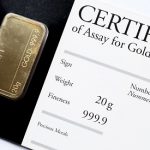In order to estimate the melt values of precious metal jewelry, antiques, or other items, you need to know exactly how much precious metal the objects contain. These types of goods are commonly made with alloys – meaning they are not 100% pure precious metal. In most cases, they bear a stamp indicating the item’s true precious metal content, or purity.
The format of precious metal purity stamps can vary depending on when and where the object was made. For example, in the United States, gold is stamped with a karat rating, while other precious metals are stamped with a millesimal fineness rating. In Europe, millesimal fineness is used to indicate the purity of all precious metal objects. A few countries don’t recognize palladium as a precious metal, so some palladium goods may not have purity stamps. There may also be additional stamps indicating country of origin, year of assay, and other types of information. For this post though, we’ll focus on how to decode the purity stamp so you can determine an item’s melt value.
As previously mentioned, most purity stamps indicate millesimal fineness – which is a measure in in parts-per-thousand of the item’s primary precious metal compared to the other metals it’s alloyed with. For example, a gold ring stamped “995” is 995 parts gold and 5 parts other metals. With the worldwide ubiquity of the precious metals market, you’d think that purity stamps would have at least 1,000 variances. But remember: millesimal fineness is a measure of an alloy’s primary metal – so it’s very uncommon to see stamps lower than 500 (with the exception of gold, which can go as low as 375). Plus, because alloy constituent ratios are mostly standardized, so are purity stamps. Below are the most common purity stamps for each precious metal:
- Gold
- 999 (24k)
- 916 (22k)
- 833 (20k)
- 750 (18k)
- 625 (15k)
- 585 (14k)
- 417 (10k)
- Silver
- 999
- 925 (sterling)
- 800
- Platinum
- 995
- 950
- 850
- Palladium
- 999
- 950
- 500
Keep in mind that the laws regarding the accuracy of purity stamps can differ depending on the country of origin, so there may be a slight discrepancy between an item’s purity stamp and its actual purity (especially on items without assayer hallmarks). To know for sure, you will need to have the item assayed. Along with a full range of assay services, Manhattan Gold & Silver also has precious metal verifiers on site that allow us to quickly confirm the purity of your precious metals. For a free payout quote, call us at 212-398-1554.











